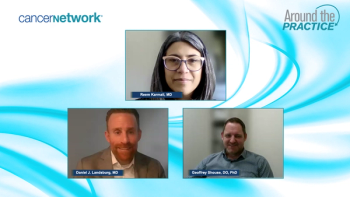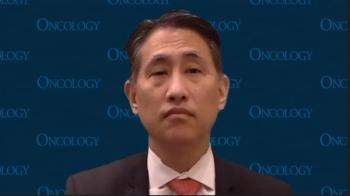
The pediatric care wing of the Jack & Sheryl Morris Cancer Center is intended to accommodate the physical and emotional needs of younger patients with cancer.

Your AI-Trained Oncology Knowledge Connection!


The pediatric care wing of the Jack & Sheryl Morris Cancer Center is intended to accommodate the physical and emotional needs of younger patients with cancer.

Panelists discuss how bridging therapies, including chemotherapy, targeted therapies, immunotherapy, and steroids, are used to control disease progression in patients awaiting CAR T therapy, with the choice of treatment depending on disease type, performance status, and the urgency of disease control.

Panelists discuss how treatment sequencing for relapsed/refractory lymphoma is influenced by factors such as disease characteristics, prior treatments, patient preferences, and adverse effect profiles, with the inclusion of Tafasitamab + R2 in the second-line setting potentially altering third-line therapy decisions.

Jennifer Moliterno, MD, FAANS, discusses effective collaboration strategies with multidisciplinary colleagues to optimize treatment for brain tumors.

Approximately 10% of patients discontinued treatment with avutometinib/defactinib due to toxicity in the phase 2 RAMP 201 trial.

Panelists discuss how the combination immunotherapy approach is superior to monotherapy for most melanoma patients, with specific exceptions such as desmoplastic melanoma where monotherapy shows remarkably high response rates.

Panelists discuss how the treatment paradigm for melanoma has evolved to favor upfront dual checkpoint blockade over targeted therapy, except in specific cases where rapid response is needed for symptomatic patients with high LDH.

Panelists discuss how early recognition, accurate diagnosis through histopathology and molecular testing, and multidisciplinary collaboration are critical for optimizing treatment strategies in epithelioid sarcoma (ES), while future research into targeted therapies holds promise for improving outcomes, especially in advanced cases.

Panelists discuss how assessing disease progression, utilizing molecular testing (eg, INI1 loss), and considering prior treatment responses are crucial for selecting appropriate second-line therapies, with targeted therapies and immunotherapies offering promising options for managing advanced or metastatic epithelioid sarcoma (ES).

Response rates appeared to be higher with avutometinib plus defactinib vs avutometinib alone in the phase 2 RAMP 201 study.

Panelists discuss how tarlatamab is administered via intravenous infusion with gradual dosing increases, emphasizing the importance of immediate postinfusion monitoring for acute reactions such as cytokine release syndrome, followed by ongoing follow-up to detect delayed adverse effects and manage potential immune-related toxicities.

Panelists discuss how tarlatamab eligibility is determined based on clinical factors such as prior treatment history, organ function, and ECOG performance status, with particular attention to how previous therapies, such as chimeric antigen receptor T-cell therapy or chemotherapy, may affect eligibility and immune system response.

Jennifer Moliterno, MD, FAANS, highlights post-operative complications that may arise after neurosurgery.

Patients who respond to avutometinib/defactinib may be maintained on treatment for long periods of time, says Rachel N. Grisham, MD.

AI has the potential to change practice patterns, improve imaging, and inform treatment planning for patients with brain tumors.

Panelists discuss how keeping management of dermatologic adverse effects “in-house” with oncology teams is often preferable to referring patients to dermatologists, though some patients occasionally benefit from specialized care for nail issues.

Panelists discuss how regular monitoring, patient education about reporting symptoms promptly, and visual assessment during biweekly visits are essential for effectively managing dermatologic adverse events.

Jennifer Moliterno, MD, FAANS, discusses current neurosurgical strategies for maximizing safe resection in newly diagnosed high-grade gliomas.

Oncology clinicians can effectively collaborate with neuroradiologists using advanced techniques to improve brain tumor characterization.

Treatment with lorlatinib might be effective regardless of the presence of central nervous system metastases, according to Misako Nagasaka, MD, PhD.

Nicholas Blondin, MD, discusses the latest advancements in immunotherapy for brain cancer as well as emerging strategies, including CAR T-cell therapy.

Most central nervous system events with lorlatinib were grade 1 or 2 in the phase 3 CROWN trial.

Panelists discuss how shared decision-making in treatment selection involves considering factors such as treatment convenience, efficacy duration, toxicity profile, access to care, and financial impact, ensuring that the chosen approach aligns with the patient’s preferences, lifestyle, and overall well-being.

Panelists discuss how selecting CAR T therapies or bispecific antibodies for relapsed/refractory follicular lymphoma (R/R FL) depends on factors such as disease characteristics, prior treatment responses, performance status, CD20 expression, and overall patient health, emphasizing the importance of a personalized approach to treatment decisions.

Treatment with lorlatinib did not increase cardiovascular events among patients with ALK-positive non–small cell lung cancer in the CROWN trial.

Having all the necessary staff together, from medical oncologists to pharmacists, helps deliver the best possible outcomes to patients with cancer.

At 5 years, 60% of patients who received lorlatinib in the phase 3 CROWN study achieved progression-free survival.

Joseph C. Landolfi, DO, CPE, and Michele Morrison, MPH, BSHA, RN, discuss how they can use their leadership roles to improve cancer care.

Findings from prior studies, such as the phase 3 VISION trial, may support the notion of combining radiopharmaceuticals with best supportive care.

Panelists discuss how conventional chemotherapy remains a key frontline treatment for advanced or metastatic epithelioid sarcoma (ES), while emerging targeted therapies, guided by molecular profiling and biomarkers like INI1 loss, offer personalized treatment options for patients with specific molecular alterations.